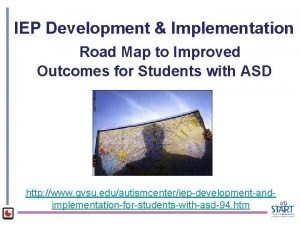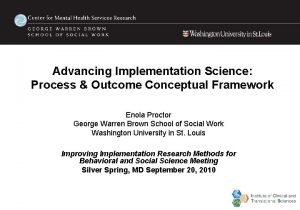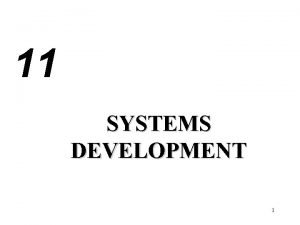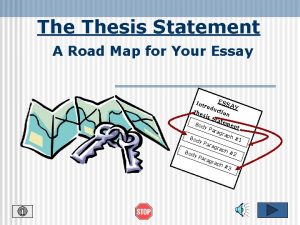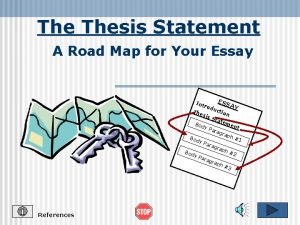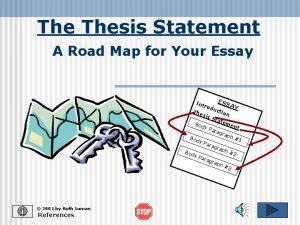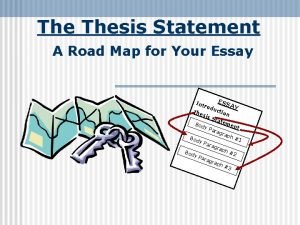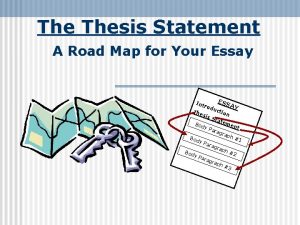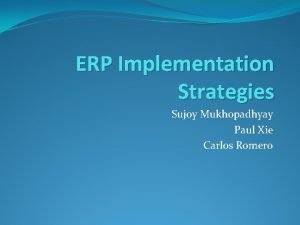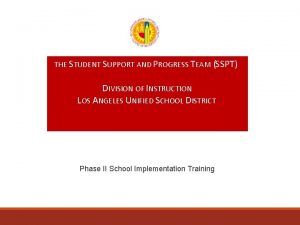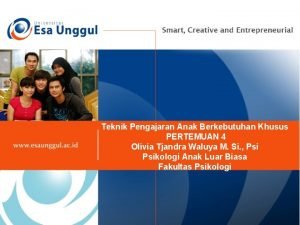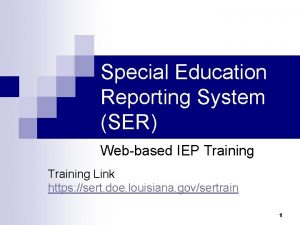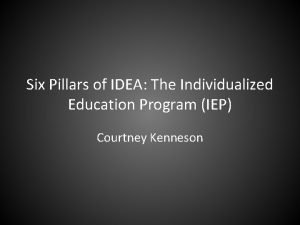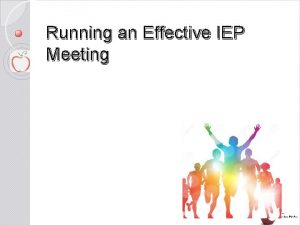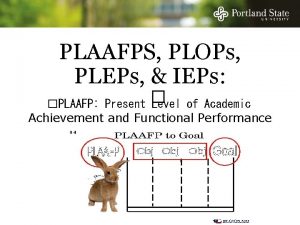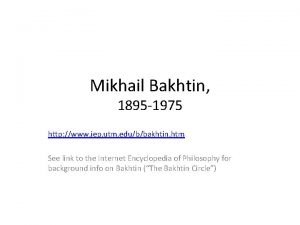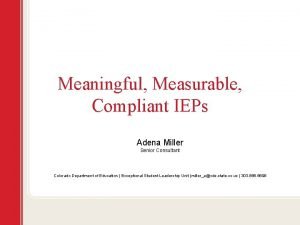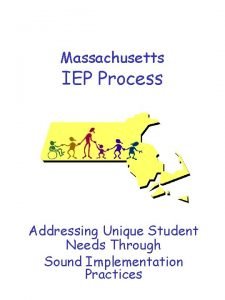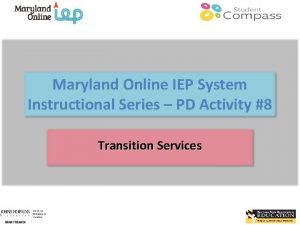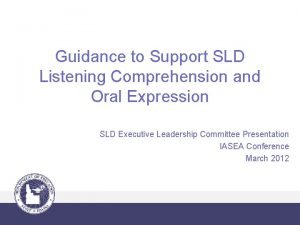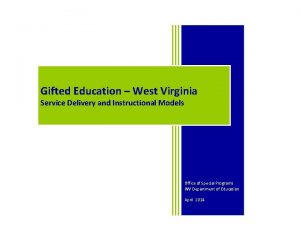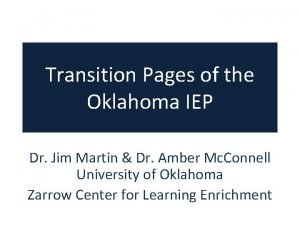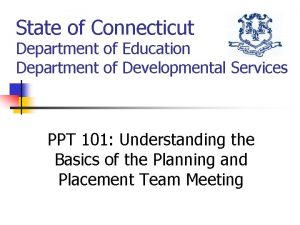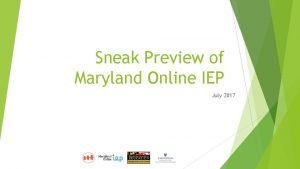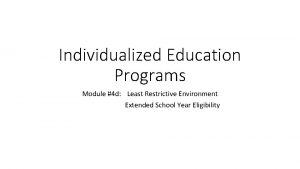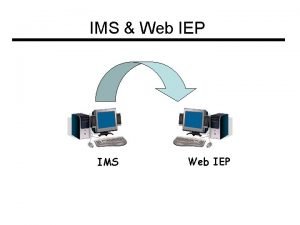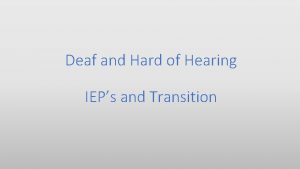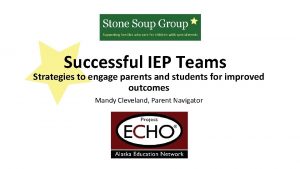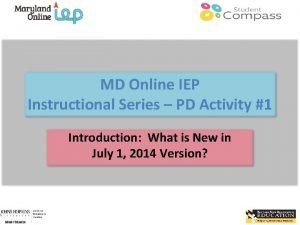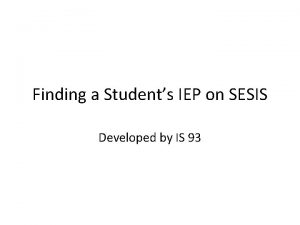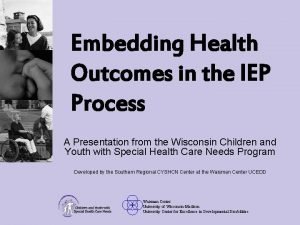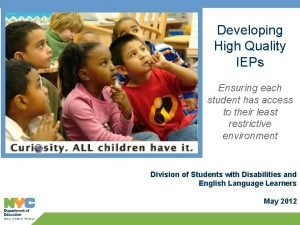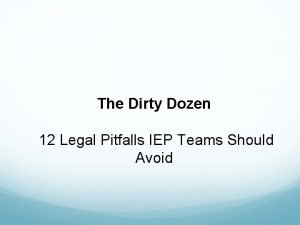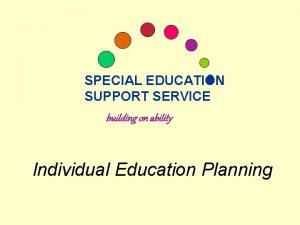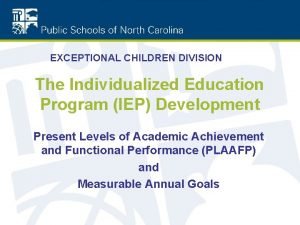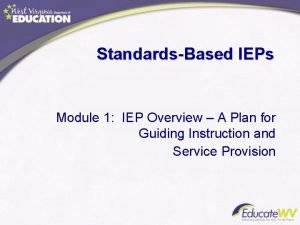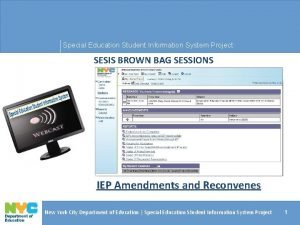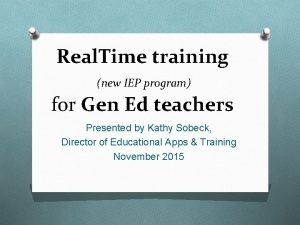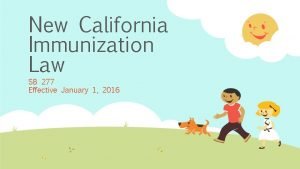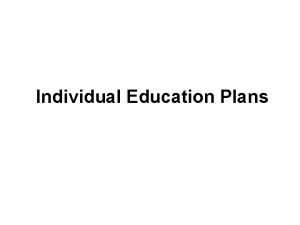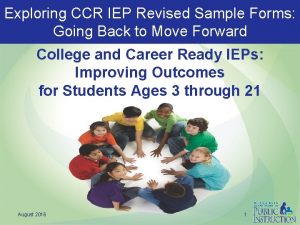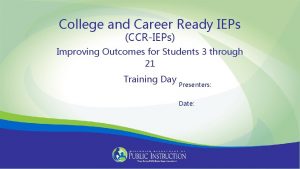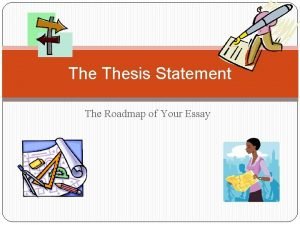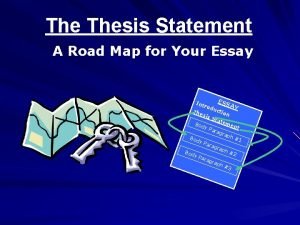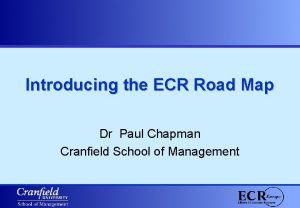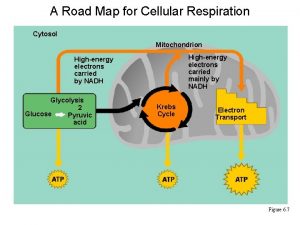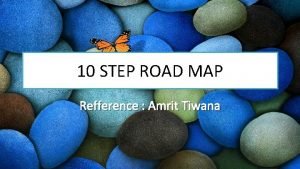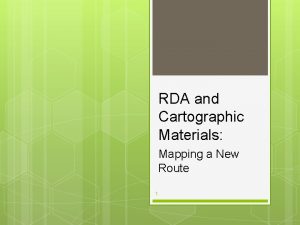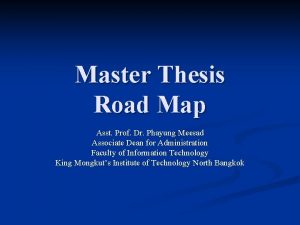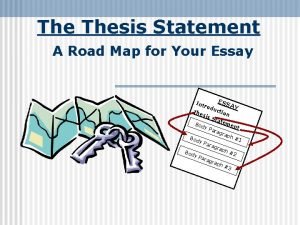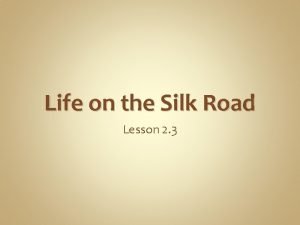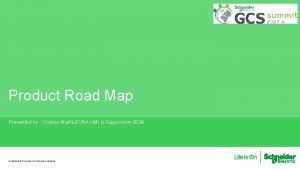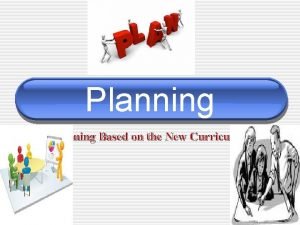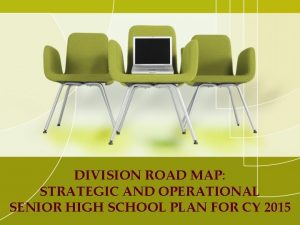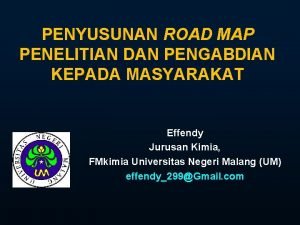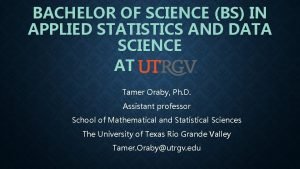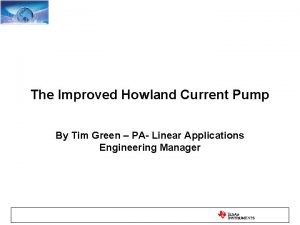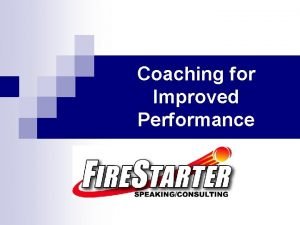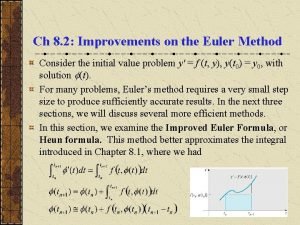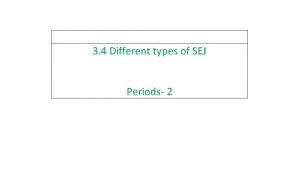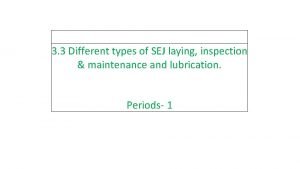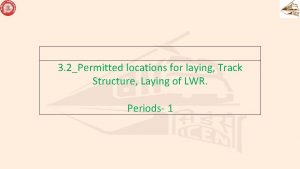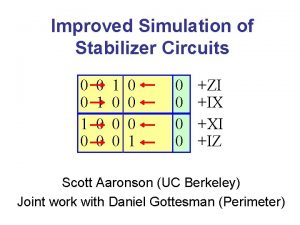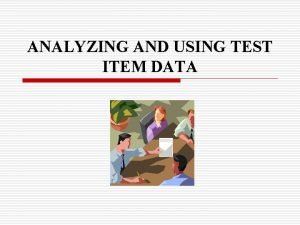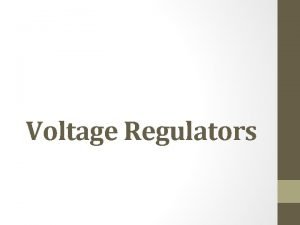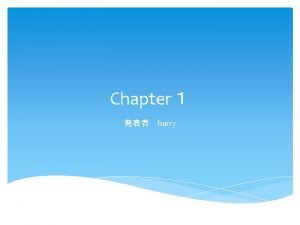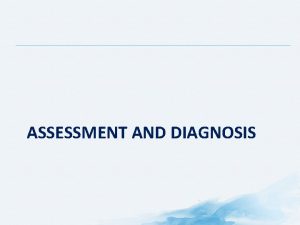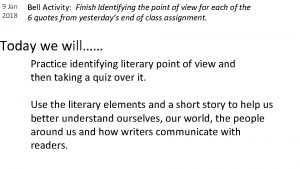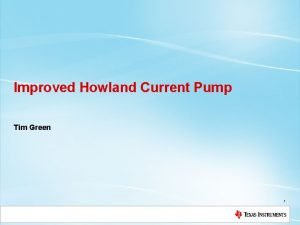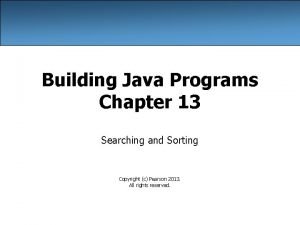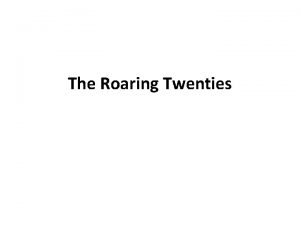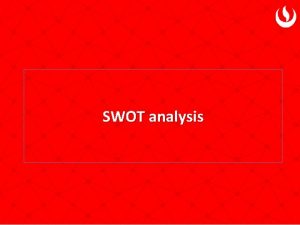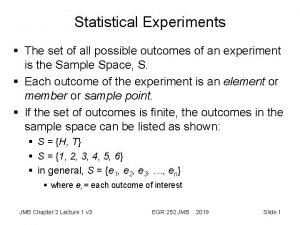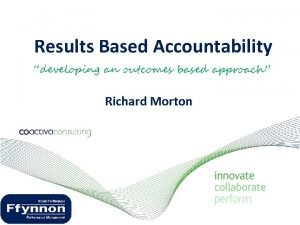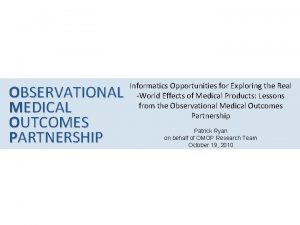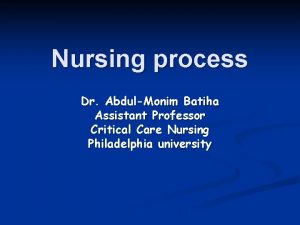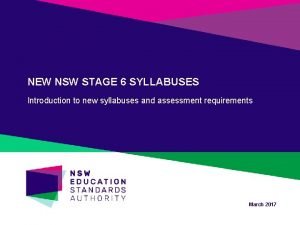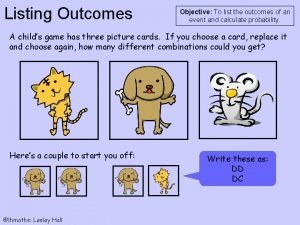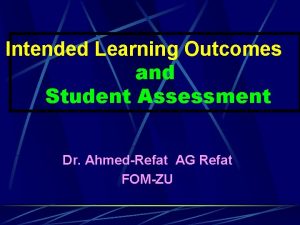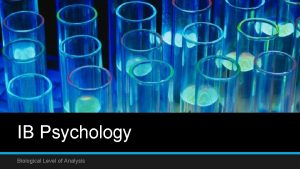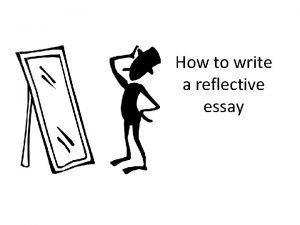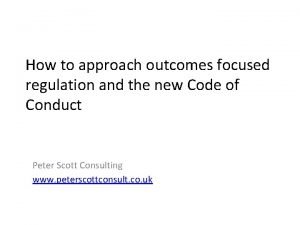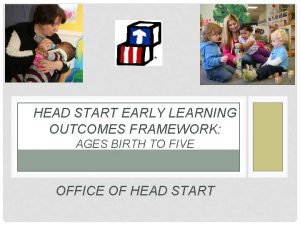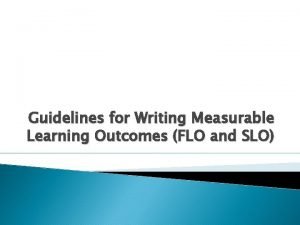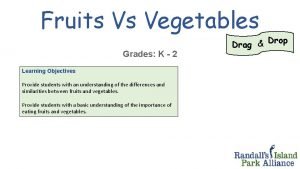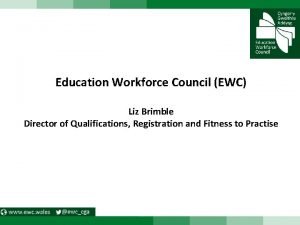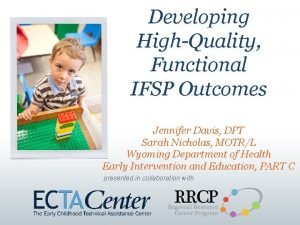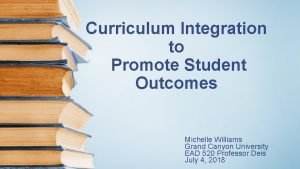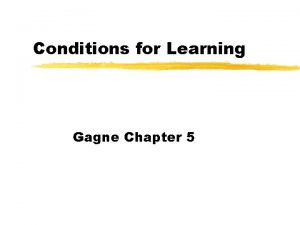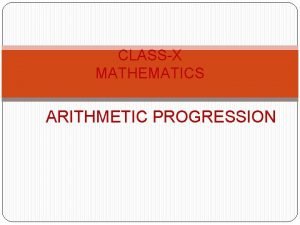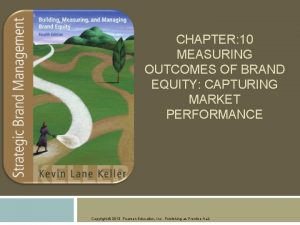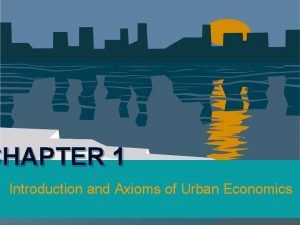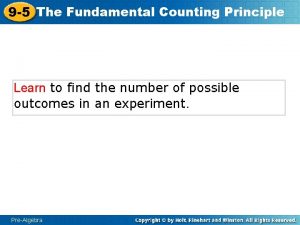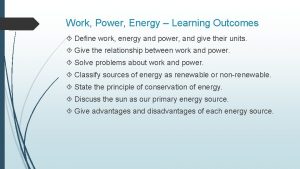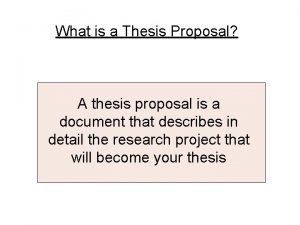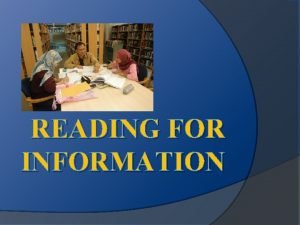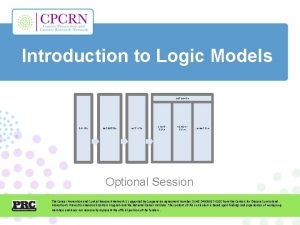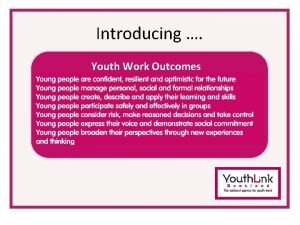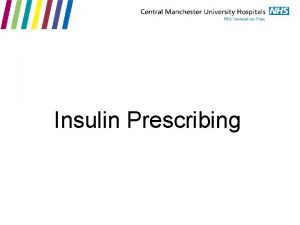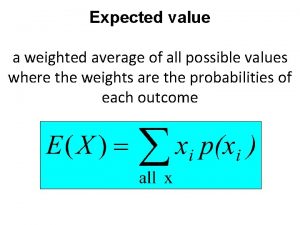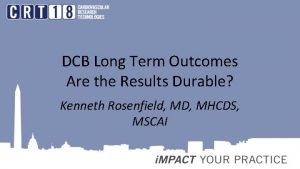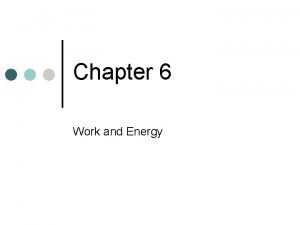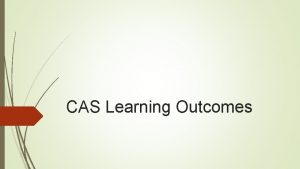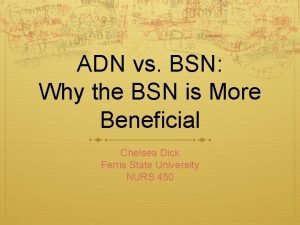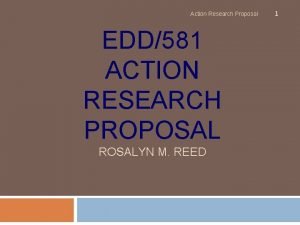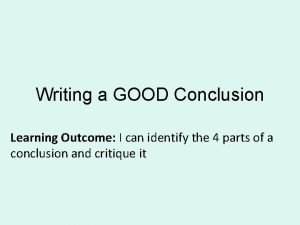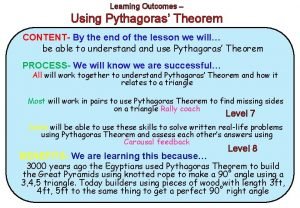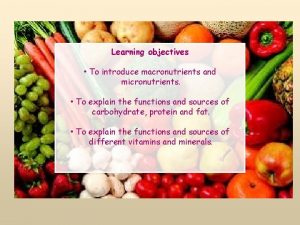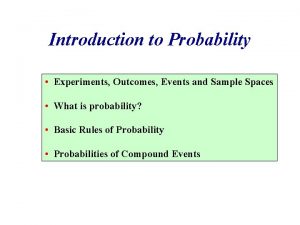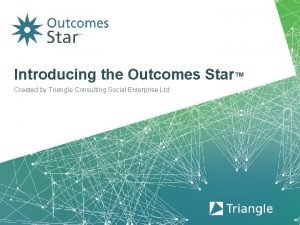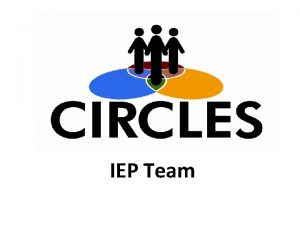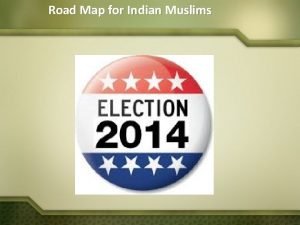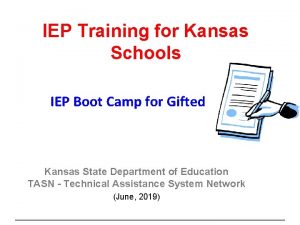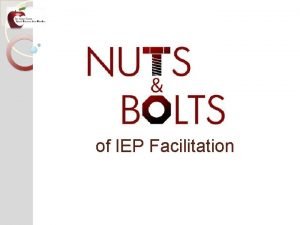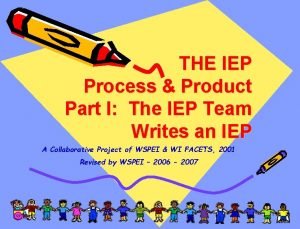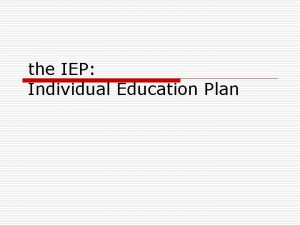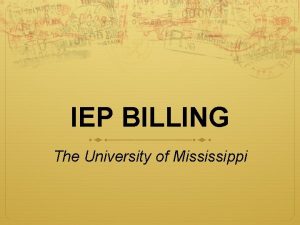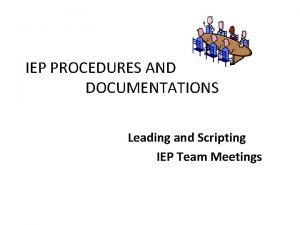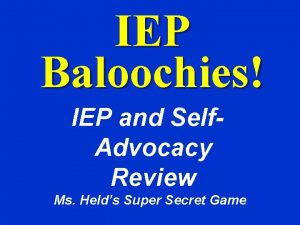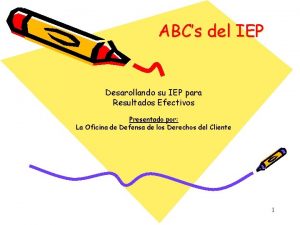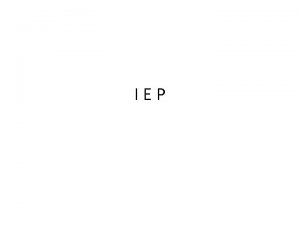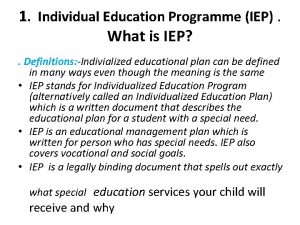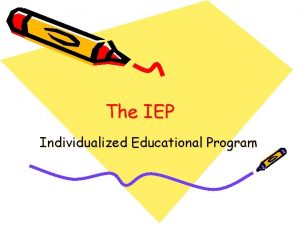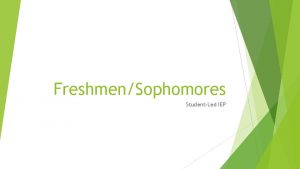IEP Development Implementation Road Map to Improved Outcomes







































































































































































- Slides: 167

IEP Development & Implementation Road Map to Improved Outcomes for Students with ASD More information about IEP Development for Students with ASD http: //www. gvsu. edu/autismcenter/iepdevelopment-and-implementation-for-students-with-asd-94. htm

INTRODUCTIONS Working Agreements Talk during Team Time (no sidebars) Technology Use Q & A Procedures

Your Learning Accountability • NOVICE • INTERMEDIATE • ADVANCED

History Lesson: IEP Module • Purpose of Tools (POC) • Implementation the follow up year • Errors in the IEP Process

Errors in the IEP Process • PLAAFP • Goals and Objectives not related to ASD • Laundry list of SAS • Standard Time for Service • Placement decisions predetermined – Lack of LRE in the Process

OR FRONTLOAD Best place to solve a problem is BEFORE it happens… … or before it happens NEXT time. Dave Schoemer

Purpose of this Module NOT Compliance Training in IEP Development “Results will no longer take a back seat to compliance. ” Eleanor White, Michigan State Director of Special Education

Purpose of this Module 2 • IS NOT – – Compliance training in IEP development Cover ALL aspects of IEP development Address issues related to ALL disabilities An IEP; Considered Pre-IEP Planning • IS – – Focus on PROCESS not FORMS Consider LRE throughout the process Address the unique needs of students with ASD Improve IEP Implementation • “IEP Implementation CONTINUES to be the most frequent state (MDE) complaint…” 2012 OSE Update Information from: http: //www. michigan. gov/documents/mde/2013_OSE_Update_430438_7. pdf

Materials for Today • 3 years of IEPs for target student (current and 2 years prior) • Most recent REED (Review of Existing Evaluation Data) • Most recent MET report • Progress reports, grades, report cards, etc. • Curriculum for target student’s grade level: – GLCEs (http: //www. michigan. gov/mde/0, 1607, 7 -140 -22709_28463 -196282 --, 00. html) – MMC (http: //www. michigan. gov/mde/0, 4615, 7 -140 -28753_64839_38924 ---, 00. html) – CCSS (http: //www. corestandards. org/read-the-standards/) • Data report for SPP #5: Education Environments: https: //www. mischooldata. org/

IEP Module AGENDA • Understanding Special Education – – History of Special Education Vocabulary Lesson Purpose of the IEP Ed Benefit Review • Developing the IEP – – The PLAAFP Supplementary Aids / Services / Personnel Supports Goals and Objectives S. E. Programs/Services and Ancillary/Related Services • IEP Implementation – Implementation Fidelity – Measuring Progress

COMMON LANGUAGE ACTIVITY IEP Module Activity Packet • Define / Describe FAPE • Define / Describe LRE • What is the purpose of an IEP? • Describe Special Education

OUR DECISIONS HAVE TO ALIGN WITH: • THE LAW • THE RESEARCH • THE DATA

WARNING • I heard that…. • I was told…. PRACTICE IS NOT NECESSARILY LAW, POLICY, or RULE Story of the Ham

History of Education • Horace Mann: – Father of American Education • Common Schools / Teach Common Values – EQUALITY • Compulsory Education – Tax $$$

SPECIAL EDUCATION HISTORY • 1954 Brown vs. Board of Education – Schools inherently unequal – “… human tendencies to prejudge, discriminate against, and stereotype other people by their ethnic, religious, physical, or cultural characteristics. . . ”

Impact of the Brown Decision • Elementary and Secondary Education Act of 1965 (underprivileged students) • PARC and MILLS: Exclusion of students with disabilities • Congressional Investigation 1972 of education of children with disabilities – Millions not served • 1975: Congress enacted P. L. 94 -142 – Children with disabilities have a RIGHT to education – Ensure ACCESS to education Wright & Wright, 2009

Individuals with Disabilities Education Act (IDEA) IDEA website https: //sites. ed. gov/idea/ • FAPE • LRE

FAPE Case Law What Does the “Appropriate” Mean? Rowley v. Hendrick Hudson Dist. (USSC 1982) 1. The state has "complied with the procedures set forth in the Act. " (ex. procedural safeguards / legal requirements, etc. ) 2. The IEP is “reasonably calculated to enable the child to receive educational benefits. ” ---interpreted as “some progress, ” “more than negligible / minimal”, but not require maximizing potential---

What is FAPE? IDEA 2004 An educational program that is individualized to a specific child, designed to meet that child's unique needs, provides access to the general curriculum, meets the grade-level standards established by the state, and from which the child receives educational benefit. (extrapolated from case law and 20 U. S. C. § 1401(14) and 34 CFR 300. 320 through 300. 324 re IEP, and 300. 17 re FAPE definition as special education and related services per IEP) Ed Benefit = progress over time (IEP goals, curriculum, social, communication, behavior, etc. )

What is FAPE? IDEA 2004 2 An educational program that is individualized to a specific child, designed to meet that child's unique needs, provides access to the general curriculum, meets the grade-level standards established by the state, and from which the child receives educational benefit. (extrapolated from case law and 20 U. S. C. § 1401(14) and 34 CFR 300. 320 through 300. 324 re IEP, and 300. 17 re FAPE definition as special education and related services per IEP) Ed Benefit = progress over time (IEP goals, curriculum, social, communication, behavior, etc. ) To provide FAPE, schools must provide students with an education that prepares the child for further education, employment, and independent living. 20 U. S. C. § 1400(c)(5)(A)(i)

ASD and Employment Reference ARC-FINDS Survey (2010) Statistic From: http: //www. thearc. org/document. doc? id=3672 85% unemployment, intellectual and developmental disabilities Autism Society of America 83% unemployment, ASD From: http: //www. autism-society. org/whatis/facts-and-statistics/ Autism Speaks From: https: //www. youtube. com/watch? v=e. D 4 G_e. L 4 h. TU&i ndex=22&list=PLcu. RHUY 9 g. Ev. RAcz. A 8 SXp 09 J 1 Sl. B Qsx. GT 5 (video-3: 55) 85% unemployment, ASD 68% unemployment, any disability

Employment Outcomes Lowest employment rate across disabilities Compared to their peers with other types of disabilities, young adults with autism had the lowest rate of employment. While 58% of those on the autism spectrum ever worked during their early 20 s, over 90% of young adults with emotional disturbance, speech impairment, or learning disability ever worked, as well as 74% of young adults with intellectual disability. Information from: http: //drexel. edu/autismoutcomes/publications-and-reports/publications/Employment-Outcomes-of-Young. Adults-on-the-Autism-Spectrum/#sthash. OQiyp. R 7 u. dpbs 2015 https: //nlts 2. sri. com/data_tables/index. html

What predicts post-school employment? • Students who had the highest degree of integration with age-appropriate peers were more likely to engage in post-school employment • IQ, behavior problems, physical disability, and individual demographics did not correlate with integrated employment outcome White, J. & Weiner, J. S. (2004). Influence of least restrictive environment and community based training on integrated employment outcomes for transitioning students with severe disabilities. Journal of Vocational Rehabilitation, 21, 149– 156.

Table of predictors for education, employment, and independent living Predictors / Outcomes Education Employment Indep. Living Career Awareness P (Potential) P -------- Community Experience -------- P -------- Exit Exam Requirements / High School Diploma Status -------- P -------- Inclusion in General Education M (Moderate) M M Interagency Collaboration P P -------- Occupational Courses P P -------- Paid Employment / Work Experience M M P Parental Involvement --------------- Program of Study -------- P -------- Self Advocacy / Self Determination P P -------- Self Care / Independent Living P P M Social Skills P P -------- Student Support P P P Transition Program M P -------- Vocational Education M M -------- Work Study -------- M -------- National Secondary Transition Technical Assistance Center (NSTTAC)

FAPE in SUMMARY Check, Star and Question • • • Compliance with the procedures Individualized Meet that child's unique needs (disability area) Access to the general curriculum (grade-level standards) Educational benefit (progress in education / goals and objectives) • Prepares the child for further education, employment, and independent living (socialization skill development / independent skills)

Individuals with Disabilities Education Act (IDEA) https: //sites. ed. gov/idea/ • FAPE • LRE

The Test for LRE “To the maximum extent appropriate, children with disabilities…. are educated in the general education classroom with children who are not disabled…”. . . and that special classes, separate schooling, or other removal of children with disabilities from regular education environment occurs only if the nature or severity of the disability is such that education in regular classes with the use of supplementary aides and services cannot be achieved satisfactorily. ” 34 C. F. R. § 300. 114

CONGRESSIONAL FINDINGS Understanding Federal Law U. S. Code (U. S. C. ) 50 Titles Title 20: Education 78 Chapters Chapter 33: IDEA — IV Subchapters Subchapter I: General Provisions 82 Sections -- denoted as § § 1400: Findings / Purpose “…the implementation of this chapter (33 : IDEA) has been impeded by low expectations, and an insufficient focus on applying replicable research on proven methods of teaching and learning for children with disabilities. ”

CONGRESSIONAL FINDINGS 2 • “Almost 30 years of research and experience has demonstrated that the education of children with disabilities can be made more effective by— – having high expectations for such children and ensuring their access to the general education curriculum in the regular classroom, to the maximum extent possible, in order to— • (i) meet developmental goals and, to the maximum extent possible, the challenging expectations that have been established for all children; and • (ii) be prepared to lead productive and independent adult lives, to the maximum extent possible; “

Recent Updates • ADA Rights • Dear Colleague 2015 • Endrew 2016 (appropriately ambitious)

The Different Kinds of “Law” • United States Constitution • Statutes passed by US Congress • Regulations created by the federal agency responsible for implementing the Statute • State Constitution • State Laws • State Administrative Rules • Case law (due process hearing/court decisions applying the law to specific factual situations)

IDEA Ancestry and Relatives • 1973: Section 504 of the Rehabilitation Act prohibits disability discrimination if get fed $ • 1974: Education of the Handicapped Act (EHA) • 1975: EHA amended by the Education for All Handicapped Children Act (EAHCA) “PL 94 -142” – This is the “mother” of what we now know as IDEA – Guarantees FAPE in the LRE for SWDs ages 3 -21 • 1977: 504 regs also incorporate FAPE and LRE • 1986: EAHCA amended to add early intervention services for infants and toddlers with disabilities B to 3 • 1990: EAHCA renamed Individuals with Disabilities Education Act (IDEA) – adding transition and assistive technology – two new disability categories, autism and TBI. •

IDEA Ancestry and Relatives 2 • 1990: Americans with Disabilities Act (ADA) expands on § 504 discrimination protections The ADA is a civil rights law that prohibits discrimination against individuals with disabilities in all areas of public life, including jobs, schools, transportation, and all public and private places that are open to the general public. • 1997: IDEA amended – discipline provisions modified – IEP process/content (progress in curriculum) • 1999: IDEA-97 regulations finally issued • 2004: IDEA amended; now IDEA-04 or IDEA 2004. – Imports many terms from NCLB – Refers to RTI as feature of appropriate instruction

IDEA, 504, and ADA Case Law 9 th Circuit Court of Appeals – Adopted amicus position of US Department of Justice and US Department of Education Office for Civil Rights – IDEA does not limit rights that students with disabilities may have under other laws, including Section 504 and the ADA – Courts are beginning to hear student cases alleging disability discrimination violations under Title II of the ADA

Dear Colleague Letter, Nov 2015 https: //www 2. ed. gov/policy/speced/guid/idea/memosdcltrs/guidance-on-fape-11 -17 -2015. pdf “Ensuring that all children, including children with disabilities, are held to rigorous academic standards and high expectations is a shared responsibility for all of us. To help make certain that children with disabilities are held to high expectations and have meaningful access to a State’s academic content standards, we write to clarify that an individualized education program (IEP) for an eligible child with a disability under the Individuals with Disabilities Education Act (IDEA) must be aligned with the State’s academic content standards for the grade in which the child is enrolled. Research has demonstrated that children with disabilities who struggle in reading and mathematics can successfully learn grade-level content and make significant academic progress when appropriate instruction, services, and supports are provided. Conversely, low expectations can lead to children with disabilities receiving less challenging instruction that reflects below grade-level content standards, and thereby not learning what they need to succeed at the grade in which they are enrolled. ”

Dear Colleague Letter, Nov 2015 2 https: //www 2. ed. gov/policy/speced/guid/idea/memosdcltrs/guidance-on-fape-11 -17 -2015. pdf “The Department recognizes that there is a very small number of children with the most significant cognitive disabilities whose performance must be measured against alternate academic achievement standards, as permitted in 34 CFR § 200. 1(d) and § 300. 160(c). As explained in prior guidance, 6 alternate academic achievement standards must be aligned with the State’s grade-level content standards. The standards must be clearly related to gradelevel content, although they may be restricted in scope or complexity or take the form of introductory or pre-requisite skills. This letter is not intended to limit a State’s ability to continue to measure the achievement of the small number of children with the most significant cognitive disabilities against alternate academic achievement standards, but rather to ensure that annual IEP goals for these children reflect high expectations and are based on the State’s content standards for the grade in which a child is enrolled. ”

Supreme Court Ruling, March 2017 Endrew v. Douglas County https: //www. supremecourt. gov/opinions/16 pdf/15 -827_0 pm 1. pdf • Student with ASD offered 5 th grade IEP that resembled 4 th grade IEP (progress stalled) so parents enrolled in private school – student made significant progress. • Parents sued for reimbursement of private school costs and lost – courts interpreted Rowley as “more than de minimis” or “some” progress • Supreme Court on Rowley: – FAPE (i. e. ed benefit) for students enrolled in gen ed is passing grades, but not maximum potential; – Rejected school’s argument that FAPE (Rowley) established little / no requirement – Did not provide guidance for students not enrolled in gen ed – Rowley: “the IEP is reasonably calculated to enable the child to make progress appropriate in light of his circumstances. ”

Supreme Court Ruling, March 2017 Endrew v. Douglas County 2 https: //www. supremecourt. gov/opinions/16 pdf/15 -827_0 pm 1. pdf “Rowley did not provide concrete guidance with respect to a child who is not fully integrated in the regular classroom and not able to achieve on grade level. A child’s IEP need not aim for grade-level advancement if that is not a reasonable prospect. But that child’s educational program must be appropriately ambitious in light of his circumstances, just as advancement from grade to grade is appropriately ambitious for most children in the regular classroom. The goals may differ, but every child should have the chance to meet challenging objectives. ”

OUR DECISIONS HAVE TO ALIGN WITH: • THE LAW • THE RESEARCH • THE DATA

The Dynamic Relationship Between Content, Curriculum and Student Learning: Three Primary Findings • The amount, type, and quality of interactions between students with extensive support needs and their typical peers were better in general education contexts. • Services in general education contexts could be superior to those in self-contained settings with respect to: – The quality of student Individualized Education Programs, the aspects of instruction and the overall program provided – The amount of time that teachers provided instruction – The amount of time students were engaged in instruction and social interactions with general education classmates • When these student received services in inclusive general education contexts, their learning outcomes could be better across skills areas and activities including: – – Social competence Language Development and Use Literacy General education content areas The Dynamic Relationship Between Context, Curriculum, and Student Learning: A Case for Inclusive Education as a Research-based Practice. Jackson, Ryndak, & Wehmeyer, (2010).

Rationale for Segregated Programming Simply Not Supported • Study: 7 years; 6 self-contained; 5 districts; 3 states • Rationale: – Community (i. e. more protective environment) • Not purposefully created or given much attention • Evidence that it, in fact, was the opposite – Less Distractions: SC more frequent; more severe – Curriculum and Instruction: (structure; individualized) • Less structure than gen ed • Context-Free / Meaningless Curriculum (i. e. little inquire-based / cooperative learning; often “seat work; ” no connection to gen ed) • No Specially Trained Instructor – mostly parapros – Behavior Supports: Confrontational staff; Few attempts to understand or respond to function; Contingent removal; Use of time out / restraints Does Self-Contained Special Education Deliver on Its Promises? A Critical Inquiry Into Research and Practice. Causton-Theoharis, Orsati, Cosier, (2011)

LRE=General Education There is STRONG Evidence that Student with “Extensive Support Needs” – Acquire skills and content knowledge (including literacy) in general education with rigorous instruction and UDLbased adaptations (e. g. differentiated instruction; universal supports, literacy supports (Kluth)) – Are BEST served by educational teams that approach their education with the intent of finding solutions to access and learning barriers rather than alternative placements. Involvement and Progress in the General Education Curriculum for Students With Extensive Support Needs: K-12 Inclusive-Education Research and Implications for the Future. Ryndak, Lewis & White, (2013).

Kurth & Mastergeorge, 2010 • 15 Ss w/ ASD (not AS) – 12 males • 7 -9 th grade; 12 -15 years old • 7 spent >80% day in Gen. Ed; math and reading instruction in Gen. Ed • 8 self-contained spent >50% in Sp. Ed; math and reading instruction in Sp. Ed • Measures: – Cognitive Gen. Ed mean 64. 9; Sp. Ed mean 60. 0 – Adaptive Gen. Ed mean 44. 4; Sp. Ed mean 42. 3 – Academic—WJ 3 • Broad Reading: Gen. Ed mean 67. 6; Sp. Ed mean 13. 1 • Broad Writing: Gen. Ed mean 83. 6; Sp. Ed mean 14. 1 • Broad Math: Gen. Ed mean 77. 4; Sp. Ed mean 8. 5 Academic and Cognitive Profiles of Student with Autism: Implications for Classroom Practice and Placement. International Journal of Special Education, 25 (2), 8 -14.

What is SPECIAL EDUCATION? --NOT a place --IS a set of supports and services to ensure ACCESS & PROGRESS in GENERAL EDUCATION WHERE the child receives special education services is the PLACEMENT…. The first “where” to consider is…

Purpose of the IEP Define Special Education necessary to assure FAPE in the LRE: Access to, participation and progress in. General Education Curriculum

P t ODE en atem 0 St 80/8 Continuum of Services MI Thresholds for Restriction SPP Indicator 5: Educational Environments 2018 Targets General Education Classroom 80%+ Target 64. 25% General Education Classroom 40 -79% General Education Classroom <40% Target 11. 4% << Less Restrictive Separate Facility Target 5. 5% More >> Information from: https: //osep. grads 360. org/services/PDCService. svc/Get. PDCDocument. File? file. Id=20476

Island in the Mainstream cartoon

District / ISD data report for SPP #5: Education Environments: https: //www. mischooldata. org/

Why do we continue to perpetuate a segregated culture? DISCUSSION

Incremental Steps YOUR ACCOUNTABILITY Your Behavior Expresses Your Belief System

Your Behavior Expresses your Belief System… DO YOU…… • Send a folder of “alternative” work with the student to the general education class? – Have “token” LRE time? Specials only? • Have all the special education students eat at one lunch table? Have a different recess? • Use of activities that are inappropriate for the age of the student (ex. Calendar / Clifford). – Exposure Breeds Preference!! • Talk about students with ASD in front of them?

Your Behavior Expresses your Belief System. DO YOU. . . • Use disability-first language? – Use “high functioning” and “low functioning” to describe students? – Talk about students based on their eligibility category rather than their name? (The Autistics) • Blame the STUDENT? – Not motivated; Not ready; Unemployable; OTHERS? • Adopt a “protective” attitude? – DIGNITY OF RISK!! • Talk about the student’s lack of perceived competency rather than their contributions? – LEAST DANGEROUS ASSUMPTION

Self Evaluation IEP Module Activity Packet Beliefs and Behaviors that PREVENT Integrated Opportunities

The point is this. . . THERE ARE BARRIERS TO SUCCESSFULLY EDUCATING STUDENTS WITH ASD… WE SHOULD NOT BE ONE OF THOSE BARRIERS… LOU BROWN

You did what you did when you knew what you knew. . . You now know different – which makes you accountable!!

Self Evaluation IEP Module Activity Packet Your Accountability to the Change Process Beliefs and Behaviors that SUPPORT Integrated Opportunities

Making Change Happen • If you write it down, you are more likely to do it…. AND…. • If you TELL someone else, you are even MORE likely to do it…. AND…. • If you post it, you are that much MORE likely to do it!

Educational Benefit Review PROCESS • Was the IEP reasonably calculated to ensure Educational Benefit? • What IS Educational Benefit? – Rowley (Supreme Court 1982)--more than minimal progress – Rowley in 2007 (aligned with IDEA 2004 / NCLB and Endrew) • • • PLAAFP related to involvement / progress in general curriculum MEASURABLE “appropriately ambitious” annual goals Services planned to support PROGRESS toward goals In the LRE (gen ed curriculum / environment) IEP adjusted if no progress made

Materials Needed • Handout in your packet • 3 years of IEPs (current year is year 1) • Most recent MET / other assessments • Most recent REED (Review of Existing Evaluation Data) • Progress Reports on IEP goals

Step 1: Complete ONE for Each Year What needs are listed in the PLAAFP? What are the supplementary aids and services? List the goals and objectives / benchmarks? What are the programs and services. What evidence of progress is available? Did the student make adequate progress?

Step 2: Analyze the Relationship Among Components Are the needs in the PLAAFP the PRIMARY ones related to the disability and access and progress in the general education CURRICULUM and ENVIRONMENTS compared to peers? Where is each need addressed in the IEP? Does EACH supplementary aid and service address a need(s) specifically listed in the PLAAFP? Are Universal Supports for students with ASD considered / addressed? Does each goal specifically address a need(s) listed in the PLAAFP? Are the goals and objectives/ benchmarks measurable? For each goal and objective/ benchmark, is there a program or service to address it? Are the programs and services designed to ensure progress on the goals and objectives / benchmarks? How did the IEP team consider LRE in the development of the programs / services? Is there objective data (i. e. direct assessment or observation) to support progress on the goals and objectives? Did the student meet the goals? If not, was the IEP re-designed to address it?

What the Core Components of the IEP Should Include

Identify the HOLES

Step 3: Analyze Relationships ACROSS Years YEAR 1 Ed Benefit? YEAR 2 YEAR 3

By End of Today • 3 years of IEPs analyzed by year • 3 IEPs analyzed across 3 years • Questions considered / answered • Determine Ed Benefit

REPORT OUT Ed Benefit? EDUCATIONAL BENEFIT Year 1 2 3 NEEDS / PLAAFP Supplementary Aids / Services Are the needs in the Does EACH PLAAFP the supplementary aid and PRIMARY ones service address a related to the disability need(s) specifically and access and listed in the PLAAFP? progress in the general education Are Universal Supports CURRICULUM and for students with ASD ENVIRONMENTS considered / compared to peers? addressed? Where is each need addressed in the IEP? Goals / Objectives Programs and Services Progress Does each goal specifically address a need(s) listed in the PLAAFP? For each goal and objective / benchmark, is there a program or service to address it/ Are the goals and objectives / benchmarks measurable? Are the programs and services designed to ensure progress on the goals and objectives / benchmarks? Is there objective data (i. e. direct assessment or observation) to support progress on the goals and objectives? How did the IEP team consider LRE in the development of the programs / services? Did the student meet the goals? If not, was the IEP redesigned to address it?

An IEP Process that…. . • Focuses on PROCESS not FORMS • Considers LRE throughout the process • Addresses the unique needs of students with ASD • Improves IEP Implementation

Using Meeting Mechanics • • • Visual Support (white / chart board) Facilitator Note-Taker (IEP Form / Computer) Process (Logical IEP Progression) Brainstorming Principles – – Democratic All ideas are considered / recognized Professional Role Elimination OTHERS (FRONTLOAD) • Decision-Making Rules – No opinion unless informed by: • Law; Research; Data

IEP Process Tools

Michigan Special Education One Pager: Timeline for Initials Notice to Parent of Intent to Implement The public agency provides written notice to the parent about where and when the district intends to implement the IEP. Within 7 school days Counted from the date of the IEP Team meeting

White Board IEP: 3 Benefits & 1 Challenge

Fatal Comments during the IEP • • “We can’t do that!” “We don’t…” “That would cost too much. ” “No student receives more than ____ minutes of service per week. ” • “We don’t have staff to…. ” • “I’m only in the building one day a week” Thrun Law Firm, P. C. & Scholten Fant, 2007

Fatal Communication Error • Lack of succinct, clear responses: Comes across like dodging answers: – “Well, it depends…” – “Well, it might, could, should, etc…. ” – “It varies…” – “Well, I’ve only seen him 3 x…”

Sentence Starters…. . • “The data suggests…. ” • “We have evidence that shows…. ” • “Our observations have shown…” • “The law indicates…. ” • “The research supports…. ”

IEP Guiding Principles: Avoid Human Nature Traps!! • All opinions informed by the law, research, & data. • We cannot change the past; We can change today to establish a different future. • Communication requires interpretation: What is said may not be what was meant. • Presume Competence (Least Dangerous Assumption) • Dignity of Risk

Pay Attention to the Signs (Facilitating Peace in the IEP Process, MAASE 2016) Looming Disagreement – Challenging questions – Request to audiotape meeting – Bringing advocate (or others) – Prescription for services – Outside reports – Insistence on particular eligibility – OTHERS? Staff Behaviors that Inhibit Consensus – Lack of data – Inaccurate / unprofessional reports – Sharing misinformation – Unclear explanations – Excessive use of jargon – Inflexible communication (“this is how we do it”) – Demonstrating lack of respect

What to BRING to the IEP • DATA: Not PLAAFP already written – Assessment Information – Observational Data – Background Knowledge • Considerations for Supp Aids and Services • Goals and Objectives / Benchmarks IDEAS NOT: “My PLAFFP” / “My GOALS”

PLAAFP Development Student Observation Tool

The Schedule Matrix for PLAFFP Development

Schedule Matrix Examples

Schedule Matrix Examples 2

Data to Support Impact and Need ENGAGEMENT

Data to Support Impact and Need INDEPENDENCE

Data to Support Impact and Need SOCIAL Early Childhood Elementary Secondary

The IEP

IEP Section 1

The PLAAFP

IEP Section 2 -A

Elicit Parent Input Guiding Principles Avoid Enhance

Passport

PLAAFP Statement MDE Model Form ONE of 3 Options • Option I: Identification of need across a number of specified areas • Option II: Narrative Approach • Option III: Designed for use with progress monitoring systems

The PLAAFP Statement of the student’s Present Levels of Academic Achievement and Functional Performance (and transition related needs). Question you are attempting to answer: How does the student’s DISABILITY impact access to and participation in & progress in: • The general education CURRICULUM • General education ENVIRONMENTS (including social skill development, independent skills, etc. )? • Further education, employment, and independent living

What about “ACADEMIC ACHIEVEMENT? ” • ED did not define “academic achievement” • 2006 IDEA Regulations: – “’Academic achievement’ generally refers to a child’s performance in academic areas (e. g. reading, math, science. . ). We believe the definition could vary depending on a child’s circumstance or situation, and therefore, we do not believe a definition of ‘academic achievement’ should be included in these regulations. ” • ASD Eligibility Requirements….

PLAAFP Statement Framework AREAS of the student’s DISABILITY that impact access to and participation & progress in: • The general education CURRICULUM • General education ENVIRONMENTS (including social skill development, independent skills, etc. )? • Ability to Participate in Instruction • Socialization Skills / Competence • Communication • Independent Skills • Transition Issues • Ability to Manage Stress / Anxiety Janzen, J. , 2003 • Behaviors

Prioritizing Areas “PLPs should be pruned to reflect the educational priorities for the period covered by the IEP…. . . ” “Without prioritizing, there is a ‘Jack of all trades, master of none’ effect, whereby too much is attempted and too little is accomplished. ” Diane Twachtman-Cullen & Jennifer Twachtman-Reilly (2002) IEP goals / objectives are not the ONLY thing you are teaching!!

PLAAFP Statement Framework AREAS of the student’s DISABILITY that impact access to and participation in & progress in: The general education CURRICULUM General education ENVIRONMENTS (including social skill development, independent skills, etc. )? • Ability to Participate in Instruction • Socialization Skills / Competence • Communication • Independent Skills • Transition Issues • Ability to Manage Stress / Anxiety • Behaviors 2 DATA for each area— COMPARED TO SAME AGE PEERS

OPTIONS for DATA • • • Standardized Measures Rating Scales State / Local Assessments Behavior Plans / Logs Classroom Output Grades / Progress on Current IEP Goals Direct Observation GLCEs MDE Quick Reference Guide: Section 2 PLAAFP

Make sure data is ACCURATE

PLAAFP Statement Framework AREAS of the student’s DISABILITY that impact access to and participation & progress in: The general education CURRICULUM General education ENVIRONMENTS (including social skill development, independent skills, etc. )? • Ability to Participate in Instruction • Socialization Skills / Competence • Communication • Independent Skills • Transition Issues • Ability to Manage Stress / Anxiety • Behaviors 3 How do these needs IMPACT Data for access to, EACH area— involvement & participation in, COMPARED success in general TO PEERS education CURRICULUM and ENVIRONMENTS?

PLAAFP Statement Guided Practice Area Social Data IMPACT Sean has 97% fewer social In the classroom, Sean does interactions than others not choose a partner or join a students the same age based work group without adult on staff observations. He talks prompting. He does not about Star Wars excessively participate in cooperative which results in peers resisting work with peers without interaction with him. He does argument, which results in not have a preferred friend, and adult intervention and 3 -4 at lunch and recess, he plays times per week, Sean having alone. According to the to leave the classroom due to “developmental inventory”, disruption. Social interactions typical peers can identify a are impacted by continual Star preferred friend and interact Wars talk. with others during play activities.

PLAAFP Statement Guided Practice 2 Area Independent Skills Data IMPACT Sean does not independently navigate the Because Sean requires daily schedule. He requires intensive adult prompting to 6 -7 verbal and visual follow the daily routine, prepare prompts by adults before for classroom activities, and following simple tasks. He complete classroom work, he does not independently get misses instruction as much as materials he needs to 40 minutes per hour. As such, complete classroom he is pulled out of the activities and tasks, and classroom to “catch up” on his requires constant adult work as much as an hour a day prompts to complete at which time he is missing the classroom work. Based on other instruction in the classroom observations, classroom. typical peers navigate the environment independently and complete their assignments with minimal adult prompting / support.

PLAAFP Statement EXAMPLE Area Behavior Data IMPACT Sean has a low frustration tolerance especially with paper / pencil academic tasks. When this occurs, which ranges from 3 -5 times per day, he whines and will not continue his work. When extremely frustrated which occurs 2 -3 times weekly, he utters swear words loud enough for peers to hear him. Based on “developmental inventory”, ‘peers his age persist when frustrated and can identify and use 2 -3 strategies for reducing frustration. Based on teacher report and classroom observations, when frustrated, Sean misses as much as 20 -30 minutes per incident of engaged time attempting to deal with his frustration. Additionally, he does not utilize strategies for reducing his frustration so he is not able to persist in academic tasks which further impacts his progress.

Team Time: Complete PLAAFP Worksheet

REPORT OUT

• Just because there is a NEED does not mean you need a GOAL— • However, you MUST address each need identified in the PLAAFP in another appropriate section of the IEP…. – Secondary Transition Considerations – Supplementary Aids and Services – Goals and Objectives / Benchmarks

Supplementary Aids and Services

What ARE Supplementary Aids / Services? • § 300. 42 Supplementary aids and services means aids, services, and other supports that are provided in regular education classes, other education-related settings, and in extracurricular and nonacademic settings, to enable children with disabilities to be educated with nondisabled children to the maximum extent appropriate in accordance with §§ 300. 114 through 300. 116. (Authority: 20 U. S. C. 1401(33))

MDE Interpretation of the Purpose of Supplementary Aids and Services • Provided to enable the student to: – Advance appropriately toward attaining the annual IEP goals. – Be involved and progress in the general education curriculum and to participate in extra-curricular and other nonacademic activities. – Be educated and participate in activities with other students with disabilities and nondisabled students. MDE OSE-EIS Quick Reference Guide: Section 5

Supplementary Aids / Services Universal Supports (the Non-Negotiables) • Visual / Organizational Supports • Functional Communication System • Accommodations / Differentiation • Peer to Peer Support • Positive Behavioral Interventions and Supports • Appropriate Adult Support

Translating PROCESS to PAPER Documenting Intensive Individualized Plans • VARIABLES: – Nature of the support varies significantly (day to day, content to content, etc. ) – Support is intensive in nature – Support includes a lot of details

Translating Process to Paper MDE Model IEP Form: Section 5 • Positive Behavior Support PLAN • Individualized Accommodation PLAN • Individualized Differentiated Instruction PLAN • Grading Matrix • Individualized Peer to Peer Support PLAN • OTHERS?

Translating Process to Paper MDE Model IEP Form

TEAM TIME Supplementary Aids and Services Worksheet

Developing GOALS and Objectives / Benchmarks

Annual Goals Measurable annual goals must be designed to… • Meet child’s needs that result from child’s disability to enable the child to be involved in and make progress in the general education curriculum • Not --Restatement of gen ed curriculum --List of EVERYTHING the student is expected to learn

What skills the student needs in order to access / master the content RATHER THAN what content the student needs to learn. DISCUSSION

What about IEP’s written for / aligned with the Content Standards? • WHY SB-IEP? – MDE Focus on Results June 09 • Excluded from gen ed curriculum; • Exposed to an alternate curriculum w/ deficit driven instruction (remediation); • Not included in district / statewide assessments – MDE IEP References • http: //www. michigan. gov/mde/0, 4615, 7 -140 -6530_6598_36168236252 --, 00. html

IEP Section 4 Option 1

What about academic goals? • No hard / fast rules • Things to consider: – Definition of “academic” – 3 tiered system of academic support – Have to know ASD—OUTPUT – Gain Rate vs. Time Spent

Identifying Goal AREAS 1. Needs that CANNOT be met through supplementary aids and services (or secondary transition)… AND / OR 2. Other Prioritized Needs and/or Supports from Supplementary Aids and Services that require “specialized instruction”

“Specially Designed Instruction” IDEA Words and Terms to Know (March 2009) Adapting the content, methodology, or the delivery of instruction to address the unique needs that result from the child's disability…. to ensure that the child has access to the general curriculum…. . Information from: http: //www. ncld. org/resources 1/glossaries/idea-terms-to-know

Supplementary Aids / Services Universal Supports (the Non-Negotiables) • Visual / Organizational Supports • Functional Communication System • Accommodations / Differentiation • Peer to Peer Support • Positive Behavioral Interventions and Supports • Appropriate Adult Support

TEAM TIME Identify Goal Areas Identifying and Writing Measurable IEP Goals and Objectives / Benchmarks IDENTIFY GOAL AREAS Of the needs listed in the PLAAFP: A. What needs CANNOT be met through supplementary aids and services (or transition services)? (these MUST be identified as goal areas) B. What needs (or supplementary aids and services to meet the needs) require specialized instruction?

Writing MEASURABLE Goals and Objectives / Benchmarks


Writing MEASURABLE IEP Goals and Objectives / Benchmarks (PROGRESS MARKERS) 1. Write an annual measurable goal with a number of separate but relevant measurable objectives. --Progress on the objectives would lead to meeting the annual goal. 2. Write an annual measurable goal with a number of timed, measurable benchmarks.

Writing Goals (Objectives / Benchmarks) UTILIZING & Under what conditions Student Will…. At what level / degree (criteria)? The IEP Form: ADD: by what date; on what assessment? Does not have line for: Utilizing

Writing Measurable Goals Formula for Success • UTILIZING—Using WHAT tool, support, system, etc. will the student learn to perform the skill? • • • Utilizing a visual schedule Using peers / peer to peer support Using a picture choice board When provided a visual prompt Using a visual functional communication system Utilizing a routine checklist When given a check schedule card Using a choice differentiation Using a self-management checklist

Evidence-Based Practices

Resources for EBPs • NPDC (http: //autismpdc. fpg. unc. edu/) • National Standards Project (http: //www. nationalautismcenter. org/national-standardsproject/phase-2/) • AIM (Autism Internet Modules) by OCALI (http: //www. autisminternetmodules. org) • AFIRM (NPDC) http: //afirm. fpg. unc. edu/afirm-modules • Association for Science in Autism Treatment (http: //www. asatonline. org/treatments_desc. htm )

Writing Measurable Goals Formula for Success • UTILIZING—Using WHAT tool, support, system, etc. will the student learn to perform the skill? • UNDER WHAT CONDITION(s)—When, Where with Whom

Writing Measurable Goals Formula for Success 2 • Condition--Under what condition should the skill be demonstrated (e. g. time, place, event)? • • During transition times During a social conversation During class discussions At lunch time During math, science, etc. During morning / lunch recess During independent work When teacher is giving instruction • During morning arrival routines • When preparing to go home

Writing Measurable Goals Formula for Success 3 • UTILIZING—Using WHAT tool, support, system, etc. will the student learn to perform the skill? • UNDER WHAT CONDITION(s)—When, Where with Whom • BEHAVIOR—Get some VERBS in your sentence – What competency / skill should change? – OBSERVABLE

BEHAVIOR Begin with the End in Mind • • • • Independently transition from activity to activity Make a choice Complete the activity independently Follow the classroom routine Complete the worksheet independently Raise hand wait to be called on Ask for help Initiate interaction with a peer Follow instructions independently Make and engage in a choice Remain in seat / area Answer content-related questions Request a food item Independently put on / take off

Writing Measurable Goals Formula for Success 4 • UTILIZING—Using WHAT tool, support, system, etc. will the student learn to perform the skill? • UNDER WHAT CONDITION(s)—When, Where with Whom • BEHAVIOR—Get some VERBS in your sentence – What competency / skill should change? – OBSERVABLE • CRITERIA— How MUCH / WELL is considered mastery (use peers for comparison)?

CRITERIA (MASTERY) • • • 4 of 5 trials / opportunities 4 of 5 items / assignments 4 of 5 days 4 of 5 class periods 80% accuracy Increase by 10% 3 times a day On 4 consecutive attempts For 15 minutes at a time Within 5 min For 15 min 4 times weekly

Mrs. Walker Cartoon

GOALS & OBJECTIVES / BENCHMARKS Guided Practice Chris will raise his hand when he needs assistance or wants to share important information. (90% of time)

GOALS & OBJECTIVES / BENCHMARKS Guided Practice 2 • Utilizing a self-management checklist (STRATEGY) Chris will raise his hand share a key idea (BEHAVIOR) during science and social studies (CONDITION) 4 of 5 opportunities (CRITERIA).

GOALS & OBJECTIVES / BENCHMARKS Guided Practice 3 • Chris will raise his hand when he needs assistance or wants to share important information. (90% of time) • Chris will ask for help and accept teacher response when he doesn’t understand something. (80% of time) • With gestural prompts from peers and adults, Chris will limit conversational ideas appropriate to the setting. (90% of time)

GOALS & OBJECTIVES / BENCHMARKS Guided Practice 4 • Utilizing peer to peer support (STRATEGY) Chris will share an idea in the topic area (BEHAVIOR) During conversations at lunch and recess (CONDITION) 4 of 5 opportunities (CRITERIA)

GOALS & OBJECTIVES / BENCHMARKS Guided Practice 5 • Kayla will use appropriate social greetings upon entering and leaving the classroom with teacher and peers (hi, bye) in 8 out of 10 trial days. • Kayla will expressively identify peers and adults by name in group and play activities with verbal prompting. (4/5 trials) • Kayla will gain the attention of a communicative partner by verbal or nonverbal means to make a request, to gain assistance, and to engage in activities. (4/5 trials)

TEAM TIME Write 3 Measurable Goals Writing Measurable IEP Goals and Objectives / Benchmarks 1. 2. Of the needs listed in the PLAAFP: A. What needs CANNOT be met through supplementary aids and services? B. What needs / supplementary aids and services require specialize instruction? Prioritize at least THREE of these areas and write at least ONE measurable goal, objective, or benchmarks for each (use GAS form if establishing benchmarks): Prioritized Area of Need CONDITION under which the goal will be taught / demonstrated: Observable BEHAVIOR: CRITERIA that establishes mastery:

Benchmarking Measurable Goals

Benchmark Example: Level of Attainment Annual Goal : Independently follow a visual schedule 4 of 5 days. 0 Given a visual “check schedule” card and the verbal instruction “check your schedule, ” with 5 -8 verbal / physical prompts, Ss will select each activity from the visual schedule and transition to the appropriate area for that activity on 2 of 5 days. +1 Given a visual “check schedule” card and the verbal instruction “check your schedule, ” with no more than 3 verbal / physical prompts, Ss will select each activity from the visual schedule and transition to the appropriate area for that activity on 2 of 5 days. +2 Given a visual “check schedule” card and the verbal instruction “check your schedule, ” with no more than 1 verbal prompts, Ss will select each activity from the visual schedule and transition to the appropriate area for that activity on 2 of 5 days. +3 Given a visual “check schedule” card and the verbal instruction “check your schedule, ” Ss will independently select each activity from the visual schedule and transition to the appropriate area for that activity on 2 of 5 days. +4 Given a visual “check schedule” card and the verbal instruction “check your schedule, ” Ss will independently select each activity from the visual schedule and transition to the appropriate area for that activity on 4 of 5 days.

Benchmark Example: Level of Attainment 2 Annual Goal : Independently follow a visual schedule 4 of 5 days. 0 Given a visual “check schedule” card and the verbal instruction “check your schedule, ” with 5 -8 verbal / physical prompts, Ss will select each activity from the visual schedule and transition to the appropriate area for that activity on 2 of 5 days. +1 Given a visual “check schedule” card and the verbal instruction “check your schedule, ” with no more than 3 verbal / physical prompts, Ss will select each activity from the visual schedule and transition to the appropriate area for that activity on 2 of 5 days. +2 Given a visual “check schedule” card and the verbal instruction “check your schedule, ” with no more than 1 verbal prompts, Ss will select each activity from the visual schedule and transition to the appropriate area for that activity on 2 of 5 days. +3 Given a visual “check schedule” card and the verbal instruction “check your schedule, ” Ss will independently select each activity from the visual schedule and transition to the appropriate area for that activity on 2 of 5 days. +4 Given a visual “check schedule” card and the verbal instruction “check your schedule, ” Ss will independently select each activity from the visual schedule and transition to the appropriate area for that activity on 4 of 5 days.

Ways to Change Criteria or Conditions Change Prompt Levels (CRITERIA) Change Setting • • • Physical prompt • Gestural prompt • Verbal prompt • Visual prompt • Independent • One setting in school Two settings in school 2 school settings plus 1 community setting Change People • No adults • Familiar adult • Unfamiliar adult • With one peer • Across multiple peers

Targets = Conditions Classroom Routines • • • Arrival Lunch Dismissal Materials Preparation OTHERS? Group Activities • • • Science Social Studies Music Reading Math Art

Utilizing the Curriculum Target Matrix, John will master 4/5 targets per academic area per semester.

Benchmark Example 3

Benchmark Example 4

TEAM TIME

Identifying Special Education Programs and Related Services

If you have a goal, you MUST have a program / service to address it…. . What service? What program? WHERE (Placement)?

Making Placement Decisions "In all cases, placement decisions must be individually determined on the basis of each child’s abilities and needs and each child’s IEP, and not solely on factors such as category of disability, severity of disability, availability of special education and related services, configuration of the service delivery system, availability of space, or administrative convenience. ” Preface, 2006 Final Federal Regulations for the IDEA

The LRE Question With supplementary aids / services AND / OR Push in ancillary / itinerant / related services can the student make adequate progress on the IEP goals and objectives? • If yes, no pull out program / services is needed…. NO RESTRICTION – GEN ED PLACEMENT…. • If no, what level of restriction is needed and for what program / related services in order to assure adequate progress on the IEP goals and objective / benchmarks AND more than minimal progress in the general education curriculum.


TEAM TIME Discussion on Special Education Programs / Services

Born to be Filed cartoon

This is not the end. It is not even the beginning of the end. But it is, perhaps, the end of the beginning. Winston S. Churchill

Implementing the IEP with Fidelity

Implementing the IEP • Fidelity Tools • Measuring / Probing Progress

IEP at a Glance IEP Implementation Fidelity Plan Student Name: _______________ District / Building: ________________ IEP Date: ______ This tool is intended to assist IEP teams in implementing identified universal supports and the IEP with fidelity. It can be used as a guide for staff to know where and when the IEP goals and supplementary aids and services are to be implemented and can be used as an observation tool for conducting implementation fidelity checks. If a Schedule Matrix was completed as part of the IEP process, it can be used as the foundation for the IEP implementation plan by simply adding the IEP information columns to the already completed Schedule Matrix. Considerations for strong implementation also include developing staff competencies in EPB, providing ongoing training and coaching needed for implementation staff, identifying needed resources, and developing communication feedback systems for the team. Additionally, specific fidelity checklists for each identified intervention can be developed and used to ensure each intervention or strategy is implemented as it was designed. This tool is intended to be reviewed monthly. Student Schedule Expectations & Instructional Outcomes IEP Goals / Objectives Targeted / Addressed Supports, Strategies, EBPs & Services Implementation Fidelity and Progress Data In this column, list the student’s daily schedule including all primary activities, courses / classes and/or transitions. In this column, identify the student’s expectations & instructional outcomes during this part of the schedule. Expectations and instructional outcomes include: • Independence Skills • Social Interaction Skills • Communication Skills • Behavioral Skills • Academic Skills including task initiation, engagement, & output For example, during “arrival, ” the instructional outcomes may include independently taking off outerwear, getting materials ready, taking a seat, and completing morning work. Identify in this column where the IEP goals and/or objectives and benchmarks from the IEP are addressed or targeted within the student’s schedule. Each IEP goal and objective or benchmark may be listed more than once in this column as most goals and objectives or benchmarks can be targeted during more than one part of the schedule. List in this column, all the supplementary aides and services (including universal supports) required to support the student in making progress on goals and objectives, meeting instructional outcomes, and navigating the environment and participating in instruction as independently as possible. These include but not limited to: Visual Supports / Strategies Peer to Peer Supports Functional Communication Systems Positive Behavioral Interventions & Supports Evidence-Based Practices Accommodations / Modifications Behavior Response / Crisis Plan Adult Support (include ONLY if previous supports require teaching or additional adult intervention)—If adult support is required, attach the “Paraprofessional Planning Tool” It is critical for IEP teams to do regular checks for evidence of implementation of the IEP and progress toward goals. This column is reserved for implementation fidelity and progress data and should be tailored to the type of data needed to demonstrate progress toward IEP goals and objectives or benchmarks and data needed to demonstration implementation fidelity. Progress data may include: Frequency / Duration Interval / Scatterplot Records Academic (e. g. CBM) START Engagement, Independence, and Social Interaction Tools Behavior Logs Prompt-Level Data Implementation Fidelity Plans and Data may include: Fidelity Checklists Staff Training and Coaching Implementation process questions (e. g. is strategy implemented where / when expected? Is staff implementing as described? Is student using the system independently? Is the student making progress using the system? )

Measuring Progress • PROBES—Things to Consider – Who – When – How Often – In What Format – Analysis – Reporting


Profile of Change

SUMMARY and IMPLEMENTATION QUESTIONS / CLARIFICATIONS SELECT at least ONE CONCEPT to IMPLEMENT
 Iep development and implementation
Iep development and implementation Proctor implementation outcomes
Proctor implementation outcomes Iep development
Iep development A road map indicating the direction of systems development
A road map indicating the direction of systems development Road map thesis
Road map thesis Thesis statement road map
Thesis statement road map Thesis definition
Thesis definition Thesis road map
Thesis road map Thesis development and road map
Thesis development and road map Vanilla approach erp
Vanilla approach erp What is paved and unpaved road
What is paved and unpaved road Feasibility study in system development life cycle
Feasibility study in system development life cycle M.p. state highway act
M.p. state highway act Iep meeting quotes
Iep meeting quotes Sspt lausd handbook
Sspt lausd handbook Contoh iep anak berkebutuhan khusus
Contoh iep anak berkebutuhan khusus Ser iep
Ser iep What are the six pillars of idea?
What are the six pillars of idea? Iep meeting agenda
Iep meeting agenda Pleps examples
Pleps examples Iep utm edu
Iep utm edu Onlineiep
Onlineiep Carol kosnitsky
Carol kosnitsky Plep a vs plep b
Plep a vs plep b Mdonline iep
Mdonline iep Iep meeting agenda
Iep meeting agenda Listening comprehension iep goals
Listening comprehension iep goals Characteristics of gifted students
Characteristics of gifted students Iep goal for citing textual evidence
Iep goal for citing textual evidence Oklahoma iep
Oklahoma iep Student-led conference script
Student-led conference script Iep components special education
Iep components special education Moiep md
Moiep md Least restrictive environment examples
Least restrictive environment examples Web iep
Web iep Iep virgen maria
Iep virgen maria Wvde iep
Wvde iep Gifted iep goals
Gifted iep goals Iep
Iep Md online iep
Md online iep Sesis iep
Sesis iep Iep
Iep Quality services iep
Quality services iep Iep trailer chassis only
Iep trailer chassis only Iep meeting do's and don'ts
Iep meeting do's and don'ts Iep process
Iep process Present levels of performance iep examples
Present levels of performance iep examples Iep
Iep Rexiona
Rexiona Realtime iep
Realtime iep Sb277 iep exemption
Sb277 iep exemption Individualized education plan
Individualized education plan Ccr iep
Ccr iep Uri aec tutoring
Uri aec tutoring Iep goal
Iep goal Road to emmaus map
Road to emmaus map Roadmap in an essay
Roadmap in an essay Road map thesis statement
Road map thesis statement Mole road map definition
Mole road map definition Reading road map
Reading road map Dr paul chapman
Dr paul chapman The map shows that on his voyages, zheng he explored *
The map shows that on his voyages, zheng he explored * Cytosol
Cytosol Knowledge management roadmap steps
Knowledge management roadmap steps Silk road mind map
Silk road mind map Rda maps
Rda maps Thesis road map
Thesis road map Sql road map
Sql road map Bharatmala project in west bengal
Bharatmala project in west bengal Thesis statement road map
Thesis statement road map Silk road map activity
Silk road map activity Future of linux
Future of linux Roadmap bdm
Roadmap bdm Curriculum road map template
Curriculum road map template Hess strand jobs
Hess strand jobs Onel de guzman wiki
Onel de guzman wiki Software engineering roadmap
Software engineering roadmap Umt dns road map
Umt dns road map Road map pengabdian kepada masyarakat
Road map pengabdian kepada masyarakat Silk road map route
Silk road map route Grams to moles formula
Grams to moles formula Utrgv roadmap
Utrgv roadmap Improved sej drawing 6902
Improved sej drawing 6902 Howland current source
Howland current source Hoetzlein origin
Hoetzlein origin Explain plant breeding for improved food quality
Explain plant breeding for improved food quality 52 kg sej drawing
52 kg sej drawing If you can't measure it, you can't manage it
If you can't measure it, you can't manage it Coaching for improved performance
Coaching for improved performance Improved euler formula
Improved euler formula Modified sej drawing no
Modified sej drawing no Improved sej modified sej drawing
Improved sej modified sej drawing Improved sej drawing 6914
Improved sej drawing 6914 Improved power grid
Improved power grid Improved simulation of stabilizer circuits
Improved simulation of stabilizer circuits Zero discrimination power
Zero discrimination power Shunt voltage regulator
Shunt voltage regulator Improved data sharing
Improved data sharing Improved
Improved Most improved player by robert grisly
Most improved player by robert grisly Perhitungan leukosit dengan kamar hitung
Perhitungan leukosit dengan kamar hitung Improved howland current pump
Improved howland current pump Improved bogo sort
Improved bogo sort Learning outcomes examples english
Learning outcomes examples english Learning outcomes of water cycle
Learning outcomes of water cycle Give a lesson plan for notice writing
Give a lesson plan for notice writing Planning phase of the nursing process
Planning phase of the nursing process What were the economic outcomes of demobilization
What were the economic outcomes of demobilization Swot analysys
Swot analysys A set of all possible outcomes
A set of all possible outcomes Learning outcomes of rhymes
Learning outcomes of rhymes A collection of all possible outcomes.
A collection of all possible outcomes. Outcomes based accountability
Outcomes based accountability Example of learning objectives
Example of learning objectives Photosynthesis chlorophyll
Photosynthesis chlorophyll Observational medical outcomes partnership
Observational medical outcomes partnership Learning outcomes of nutrition in plants
Learning outcomes of nutrition in plants Nusing care plan
Nusing care plan English life skills stage 6
English life skills stage 6 Ncbts strands
Ncbts strands List of outcomes
List of outcomes Objectives of linear equations in one variable
Objectives of linear equations in one variable Learning outcomes generator
Learning outcomes generator Learning outcomes of reported speech
Learning outcomes of reported speech Purpose of learning outcomes
Purpose of learning outcomes Output devices
Output devices Mri ib psychology
Mri ib psychology Reflective essay on learning outcomes
Reflective essay on learning outcomes Outcomes focused regulation
Outcomes focused regulation Learning outcomes of holy week
Learning outcomes of holy week Learning outcomes of holy week
Learning outcomes of holy week Headstart early learning outcomes framework
Headstart early learning outcomes framework Outcome example
Outcome example Learning outcomes of vegetables
Learning outcomes of vegetables Education workforce council
Education workforce council Examples of ifsp outcomes and strategies
Examples of ifsp outcomes and strategies Curriculum integration to promote student outcomes
Curriculum integration to promote student outcomes Gagne's five categories of learning
Gagne's five categories of learning Arithmetic
Arithmetic What i learnt from the chapter a gift of chappals
What i learnt from the chapter a gift of chappals Brand based comparative approach
Brand based comparative approach Axioms of urban economics
Axioms of urban economics Reteach 9-5 math 7 fundamental counting principle
Reteach 9-5 math 7 fundamental counting principle Learning outcomes of work and energy
Learning outcomes of work and energy Expected outcomes in research examples
Expected outcomes in research examples Learning objectives of profit and loss
Learning objectives of profit and loss Reading outcomes
Reading outcomes Program specific outcomes nba
Program specific outcomes nba Cooking learning outcomes
Cooking learning outcomes Domain 1 of ppst
Domain 1 of ppst Nidhina case
Nidhina case Inputs, activities, outputs, outcomes
Inputs, activities, outputs, outcomes Youth work outcomes
Youth work outcomes Novorapid sliding scale
Novorapid sliding scale Expected value example
Expected value example Dcb clinical outcomes
Dcb clinical outcomes Learning objectives of work and energy
Learning objectives of work and energy Cas learning outcomes
Cas learning outcomes Benefits of bsn vs adn
Benefits of bsn vs adn Expected output example
Expected output example Conclusion of learning outcomes
Conclusion of learning outcomes Chapter 13 section 4 the power of the church
Chapter 13 section 4 the power of the church Outcome based assessment in ecd
Outcome based assessment in ecd Pythagoras theorem
Pythagoras theorem Objectives of vitamins
Objectives of vitamins Sample outcome
Sample outcome Outcome star triangle
Outcome star triangle Aims objectives outcomes
Aims objectives outcomes
